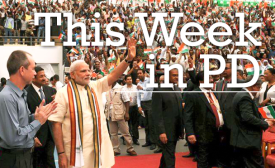narendra modi
On the second day of his trip to China, Prime Minister Narendra Modi went viral. Shortly after presiding over a stunning joint demonstration of yoga and Chinese Tai chi at the iconic Temple of Heaven, Modi snapped a selfie with his counterpart Li Keqiang.
With Indian Prime Minister Narendra Modi currently on a three nation visit to May 19, all eyes will be on his time in China. His stops in South Korea and Mongolia will receive less attention.
While dragons have been the symbol of imperial power for centuries in the Middle Kingdom, its government prefers to use the cuddly panda as a diplomatic gift to project its softer side. The dragon-to-panda transformation is a carefully thought-out image makeover by China’s top leadership: with their rising global power, they understand the need to reassure the world that they are a force for good, more like the panda than the dragon
Chinese President Xi Jinping hosted Indian Prime Minister Narendra Modi in his ancestral home town at the start of a three-day visit to China on Thursday as the two Asian giants work to boost economic ties despite decades of mistrust.
Buddhism and yoga will form part of Indian Prime Minister Narendra Modi’s soft power diplomacy as he visits China today and tries to increase his nation’s influence in the world’s second-largest economy. Modi, who heads a 50-strong delegation, arrived in the ancient city of Xian – the home town of President Xi Jinping – this morning at the start of a three-day trip.
Indian Prime Minister Narendra Modi will soon be completing his first full year in office. While he has his critics, there tends to be broad agreement that Modi has done a robust job in the sphere of foreign policy. Modi’s approach has focused on economics, soft power, connectivity, and maritime security. Modi has been deft at using what Joseph Nye has dubbed “smart power” – the right blend of soft power and hard power.

Utilizing social media, cultural diplomacy, and traditional regional ties Modi seeks to strengthen India´s soft power.
When India’s premier wanted to signal a thaw in relations with rival Pakistan recently, he didn’t call a press conference or make a televised speech. He tweeted. (...) Since Mr. Modi took office last year as leader of the world’s largest democracy, policy pronouncements have come in 140-character snippets. He has used Twitter and other social-media services to engage in diplomacy and build his image in a way few other global leaders have.







